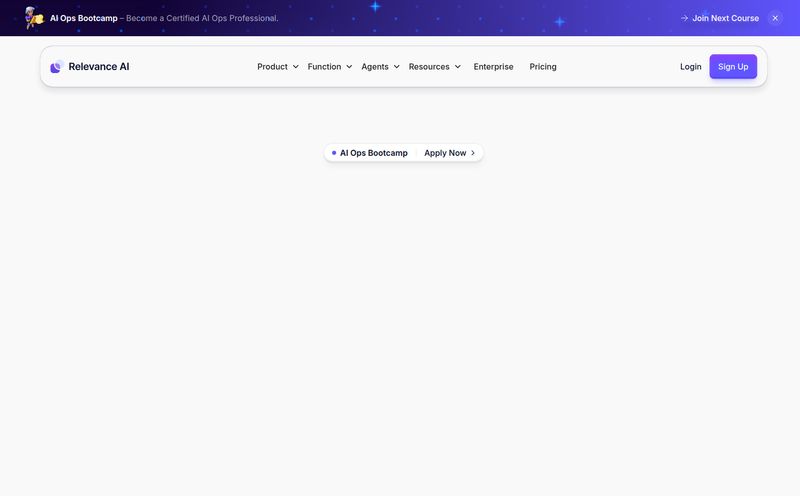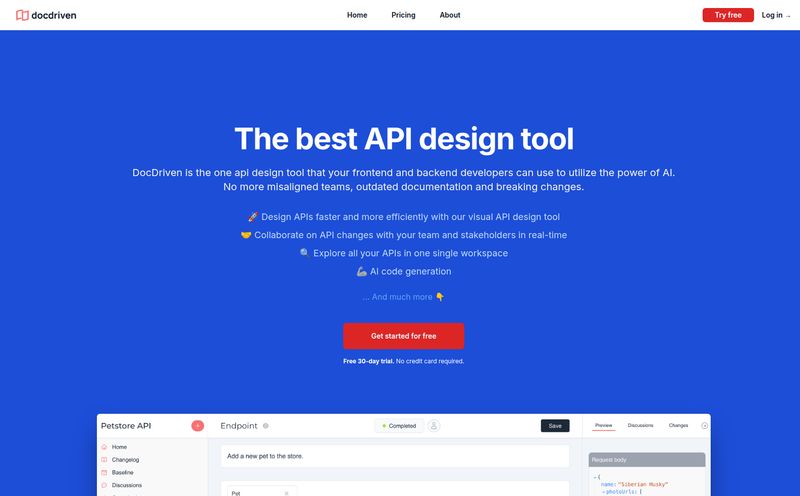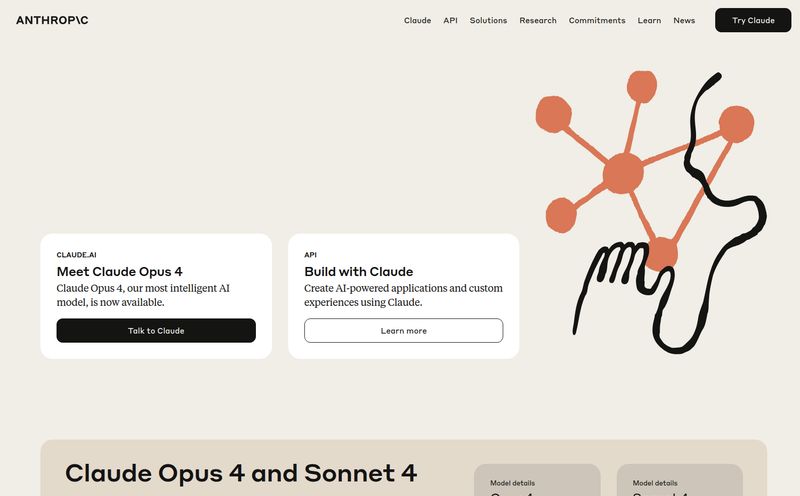As someone who’s been neck-deep in the SEO and digital marketing world for years, I get a little thrill whenever a new tool pops up that promises to make my life easier. We’ve all been there, right? Staring at a mountain of unstructured data—customer reviews, support tickets, survey responses—and just… sighing. The task of manually sorting and classifying all that text is a soul-crushing, time-sucking vortex of a job. It's the kind of work that makes you question your career choices.
So, when I first stumbled upon a tool called Ramen AI, my ears perked up. The pitch was music to my ears: a modern, complete toolset for LLM-based text classification that required no model training and no pre-labeled data. It sounded like the perfect shortcut, a ready-made cake mix for the complex, from-scratch recipe that is AI model building.
I bookmarked it, excited to give it a spin. But when I went back to check it out recently, I hit a digital dead end. The website was gone, replaced by a single, stark sentence: "This service has been suspended by its owner."
Oof. It’s like discovering a cool new coffee shop only to find it boarded up a week later. So, what happened? While we might not get the full story, I think it's worth taking a look at what Ramen AI promised. It’s a fascinating case study in the wild, fast-moving world of AI startups and a lesson in what the market is truly hungry for.
What Was the Big Idea Behind Ramen AI?
At its core, Ramen AI was designed to solve one of the biggest bottlenecks in applied AI: text classification. Think about it. You want to know if customer feedback is positive, negative, or neutral. You need to route support tickets to the right department—Billing, Technical Support, Sales. You want to analyze open-ended survey answers for common themes. Traditionally, this meant either paying a team of people to read and tag everything manually (expensive and slow) or hiring data scientists to build a custom machine learning model (even more expensive and really slow).
Ramen AI wanted to blow up that entire process. By using the power of Large Language Models (LLMs), the same tech behind tools like ChatGPT, it offered a solution that worked straight out of the box. You could, in theory, build a custom classification app in a matter of minutes, not months. This wasn't just for developers; it was for product managers, marketers, operations folks—anyone drowning in text.
A Look at the Killer (But Now Ghostly) Feature Set
The promise was one thing, but the feature list was what really got my attention. It was clear the creators understood the real-world workflow and its pain points.
Zero Training and No Labeled Data Needed
This was the showstopper. The biggest hurdle for most AI projects is the data. You need thousands of examples, all meticulously labeled by humans, just to get a model to understand what you want. Ramen AI claimed to bypass this entirely. You could just define your categories—like 'Bug Report', 'Feature Request', 'Praise'—and the LLM would be smart enough to sort new text accordingly. This wasn't just a time-saver; it was a complete game-changer, potentially saving tens of thousands of dollars in data labeling costs.
A Complete Toolkit in One Box
Ramen AI wasn't just a simple API. It was positioned as an end-to-end platform. It gave you tools to build, test, monitor, and scale your classification app. One feature I particularly loved the sound of was the one-click version control. This is huge. It means you could experiment with new categories or tweak your instructions without fear of breaking your finely tuned production app. It’s a safety net that encourages innovation, which is something many tools overlook.

Visit Ramen AI
Making AI Accessible, Even in a Spreadsheet!
Okay, this is the part that made the marketing nerd in me do a little dance. Alongside a standard API, Ramen AI offered a Google Sheet Formula. Let that sink in. You could run a sophisticated AI classification model by typing a formula into a cell in Google Sheets, just like =SUM(A1:A2). This is brilliant! It lowers the barrier to entry to practically zero. Suddenly, every marketer with a sheet of customer comments could perform sentiment analysis without writing a single line of code. That’s how you democratize technology.
Smarter Testing and Built-in Analytics
How do you know if your classifier is actually any good? Ramen AI had an answer for that, too. It included a comprehensive evaluation toolkit that measured things like precision and recall and could generate a confusion matrix. In simple terms, it didn't just tell you the score; it showed you where the AI was getting confused (e.g., mistaking 'Feature Requests' for 'Bug Reports'). Plus, it offered usage monitoring, so you could see trends over time. Again, this shows a deep understanding of what a real user needs to not only launch but also maintain a system.
The Million-Dollar Question: So, What Happened?
This is all speculation on my part, of course. A “service suspended” message can mean a lot of things in the startup world.
- Ran out of runway? The AI space is incredibly expensive. GPU time costs a fortune, and competing for talent is a bloodsport. It's possible the funding just dried up before they could find a solid product-market fit or a sustainable business model.
- An Acqui-hire? The team could have been scooped up by a larger company that wanted their talent and tech, shutting down the public-facing product in the process. This happens all the time.
- Technical Hurdles? Maybe the promise was harder to deliver than it seemed. Relying on third-party LLMs can be tricky, and keeping performance accurate, fast, and cheap is a constant balancing act.
The fact that there was no public pricing page might be a clue. It suggests they were still in a beta or early-access phase, perhaps struggling to figure out how to monetize the platform effectively. In the current AI gold rush, many tools are popping up, but only the ones with a rock-solid business plan will survive. It's a tough, tough market.
Lessons Learned from a Digital Ghost Ship
Even though Ramen AI is gone (for now, at least), its ghost teaches us a few things. The idea of Ramen AI was spot-on. It correctly identified a massive pain point and proposed an elegant, modern solution. The demand for powerful, accessible, no-code AI tools isn't going away—it's exploding.
The platform’s focus on a complete workflow—from building and testing with version control to monitoring—is precisely what separates a professional tool from a hobbyist project. And that Google Sheets integration? Pure genius. It’s a reminder that the most powerful technology is useless if people can’t easily fit it into their existing work habits.
So, while we might not be able to sign up for Ramen AI today, its memory serves as a blueprint for what a successful AI tool should look like. I'll be keeping an eye out for the next startup that tries to tackle this problem. Hopefully, they’ll stick around.
Frequently Asked Questions
- What was Ramen AI?
- Ramen AI was a platform designed for AI-powered text classification. Its main selling point was that it used Large Language Models (LLMs) to allow users to build classification apps in minutes without needing to train models or prepare labeled data.
- What was Ramen AI's main benefit?
- Its biggest benefit was speed and accessibility. It promised to save companies immense amounts of time and money by eliminating the need for manual data labeling and complex model development, even allowing non-technical users to build classifiers through a Google Sheets integration.
- Is Ramen AI still available?
- No. As of late, the service's website displays a message stating, "This service has been suspended by its owner." The platform is not currently accessible to the public.
- How much did Ramen AI cost?
- There was no public information available about its pricing. The platform was likely in a free beta or early-access stage, as no pricing page was ever launched. It was promoted as being "free to get started."
- Are there alternatives to Ramen AI?
- Yes, absolutely. While perhaps not as all-in-one, you can achieve similar results using the APIs of foundational models like OpenAI's GPT series or Cohere's classification endpoints. There are also other no-code AI platforms emerging that target similar use cases.
A Final Thought
The story of Ramen AI is a classic tale from the tech frontier. It was a brilliant, promising idea that, for whatever reason, flickered out before it could truly shine. But it's a powerful reminder of the direction the industry is heading: toward smarter, faster, and more user-friendly tools that put the power of AI into everyone's hands. I, for one, can't wait to see who picks up the torch.
Reference and Sources
- For text classification alternatives: OpenAI API Platform
- Another leading classification API provider: Cohere
- A great read on the challenges of AI startups: The New Rules of AI Startups (Harvard Business Review)



